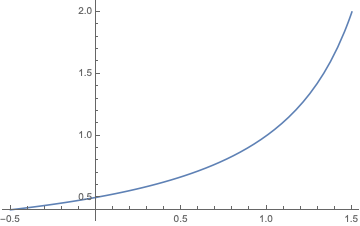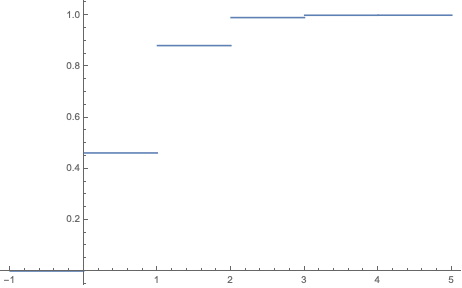Example Problems Conditional Probability and Probability Functions
ST701 Homework 2 on Conditional Probability and Probability Functions
Problems: 1.24, 1.34, 1.38, 1.39, 1.51, 1.53
1.24
Two players, $A$ and $B$, alternatively and independently flip a coin and the first player to obtain a head wins. Assume player $A$ flips first.
a.
If the coin is fair, what is the probability that $A$ wins
If player $A$ wins, that means that there have been an odd number of flips. One of these flips is a success tails (generally, with probability $p$) and the others (an even number) are tails (generally, with probability $1-p$). We can model this summation and use a geometric series to get a closed form.
\[\begin{align} P(A\ wins) & = p\cdot \sum^{\infty}_{i\in evens}(1-p)^{i/2}\cdot (1-p)^{i/2} \\ & = p\cdot \sum^{\infty}_{i\in evens}(1-p)^{i}\\ & = p \cdot \frac{ 1 }{ 1-(1-p)^2 }\\ & = \frac{ 2 }{ 3 } & \text{with } p=0.5 \end{align}\]b.
Suppose that $P(head) = p$, not necessarily $\frac{ 1 }{ 2 }$. What is the probability that $A$ wins?
From above $P(A\ wins) = \frac{ p }{ 1-(1-p)^2 }$.
c.
Show that for all $p$, $0 < p < 1$, $P(A\ wins) > \frac{ 1 }{ 2 }$. (Hint: Try to write $P(A\ wins)$ in terms of the events $E_1, E_2, \dots$ where $E_i = \text{ {head first appears on ith toss} }$).
We we look at the derivative of our function, we will see that it is always positive for $0 < p < 1$.
\[\frac{ d P(A\ wins) }{ dp } = \frac{1}{(p-2)^2}\]We can also look at the graph of $P(A \ wins)$ vs. $p$. Note that at $p=0$, $P(A \ wins)=0.5$.

1.34
Two litters of a particular rodent species have been born, one with two brown-haired and one gray-haired (litter 1), and the other with three brown-haired and two grayhaired (litter 2). We select a litter at random and then select an offspring at random from the selected litter.
a.
What is the probability that the animal chosen is brown-haired?
\[\begin{align} P(Brown) & = P((Brown \cap Litter 1) \cup (Brown \cap Litter 2))\\ & = P(Brown \cap Litter 1) + P(Brown \cap Litter 2) & \text{disjoint events} \\ & = \frac{ 1 }{ 2 }\cdot \frac{ 2 }{ 3 } + \frac{ 1 }{ 2 }\cdot \frac{ 3 }{ 5 }\\ & = \frac{ 19 }{ 30 } \end{align}\]b.
Given that a brown-haired offspring was selected, what is the probability that the sampling was from litter 1?
\[\begin{align} P(Litter 1 | Brown ) & = \frac{ P(Brown \cap Litter 1) }{ P(Brown) } \\ & = \frac{ \frac{ 1 }{ 2 } \cdot \frac{ 2 }{ 3 }}{ \frac{ 19 }{ 30 } }\\ & = \frac{ 10 }{ 19 } \end{align}\]1.38
Prove each of the following statements (Assume that any conditioning event has positive probability.
a.
If $P(B)=1$, then $P(A|B) = P(A)$ for any $A$.
\[\begin{align} P(A|B) & = \frac{ P(A\cap B) }{ P(B) }\\ & = \frac{ P(A \cap B) }{ 1 }\\ & = P(A) - P(A \cap B^C) \\ & = P(A) - 0 & \text{Since } B^C = \varnothing\\ & = P(A) \end{align}\]b.
If $A \subset B$, then $P(B|A)=1$ and $P(A|B)=P(A)/P(B)$.
Notice that because $A \subset B$, $P(A\cap B) = P(A)$ and $P(A \cap B^C) = \varnothing$.
\[\begin{align} P(B|A)& = \frac{ P(A\cap B) }{ P(A) } \\ & = \frac{ P(A) }{ P(A) } & \text{by subset}\\ & = 1 \end{align}\] \[\begin{align} P(A|B) & = \frac{ P(A\cap B) }{ P(B) } \\ & = \frac{ P(A) - P(A \cap B^C) }{ P(B) }\\ & = \frac{ P(A) - 0 }{ P(B) }\\ & = \frac{ P(A) }{ P(B) } \end{align}\]c.
If $A$ and $B$ are mutually exclusive, then
\[P(A|A\cup B) = \frac{ P(A) }{ P(A)+P(B) }.\] \[\begin{align} P(A|A\cup B) & = \frac{ P(A \cap (A \cup B)) }{ P(A\cup B) }\\ & = \frac{ P(A \cap (A \cup B)) }{ P(A) + P(B) } & \text{by mutual exclusivity} \\ & = \frac{ P( (A \cap A) \cup (A \cap B)) }{ P(A) + P(B) } \\ & = \frac{ P(A \cup (\varnothing)) }{ P(A) + P(B) } & \text{by mutual exclusivity}\\ & = \frac{ P(A) }{ P(A) + P(B) } \\ \end{align}\]d.
$P(A \cap B \cap C) = P(A|B\cap C)P(B|C)P(C)$
\[\begin{align} P(A\cap B \cap C) & = P(A \cap (B \cap C))\\ & = P(A|B\cap C)P(B \cap C) \\ & = P(A|B\cap C)P(B|C)P(C) \end{align}\]1.39
A pair of events $A$ and $B$ cannot be simultaneously mutually exclusive and independent. Prove that if $P(A)>0$ and $P(B)>0$, then:
a.
If $A$ and $B$ are mutually exclusive, they cannot be independent.
| Recall that if $A$ and $B$ are independent, than $P(A | B) = P(A)$. However, |
Thus, $A$ and $B$ cannot be independent.
b.
If $A$ and $B$ are independent, they cannot be mutually exclusive.
Recall that if $A$ and $B$ are mutually exclusive, then $P(A\cap B) = 0$. However,
\[\begin{align} P(A\cap B) & = P(A)\cdot P(B) \neq 0& \text{by independence} \end{align}\]Thus, $A$ and $B$ cannot be mutually exclusive.
1.51
An appliance store receives a shipment of 30 microwave ovens, 5 of which are (unknown to the manager) defective. The store manager selects 4 oven at random, without replacement, and tests to see to see if they are defective. Let $X=$ number of defectives found. Calculate the pmf and cdf of $X$ and plot the cdf.
Notice that $X\sim Hypergeometric(n = 30, r = 5, m = 4)$. Thus, the PMF is
\[P_X(x)= \begin{cases} \begin{align} & \frac{ {5 \choose x} \cdot {30 - 5 \choose 4 - x}}{ {30 \choose 4} } & x \in \{0, 1, 2, 3, 4\} \\ & 0 & \text{Otherwise.} \end{align} \end{cases}\]The CDF is
\[F_X(x) = \sum_{i=0}^x \frac{ {5 \choose x} \cdot {25 \choose 4 - x}}{ {30 \choose 4} }\] \[F_X(x)= \begin{cases} \begin{align} & 0 & x \leq 0\\ & 0.461595 & 0 < x \leq 1\\ & 0.881266 & 1 < x \leq 2 \\ & 0.990695 & 2 < x \leq 3 \\ & 0.999818 & 3 < x \leq 4 \\ & 1 & 4 \leq x \end{align} \end{cases}\]
1.53
A certain river floods every year. Suppose that the low-water mark is set at 1 and the high-water mark $Y$ has distribution function
\[\begin{align} F_Y(y) &= P(Y\leq y) = 1 - \frac{ 1 }{ y^2 }, & 1 \leq y < \infty \end{align}\]a.
Verify that $F_Y(y)$ is a cdf.
To verify that $F_Y(y)$ is a cdf, we must show three properties.
1) That its limits go to 0 and 1.
\[\lim_{y\rightarrow \infty} 1 - \frac{ 1 }{ y^2 } = 1 - 0 = 1\] \[\lim_{y\rightarrow - \infty} 1 - \frac{ 1 }{ y^2 } = 0\]2) The function is nondecreasing. To show this we will take the derivative. Notice that it is always postive over the range $[1, \infty)$.
\[F'_Y(y) = 0 - \frac{ -2 }{ y^3 } = \frac{ 2 }{ y^3 }\]3) The function is right continuous. Take $\epsilon > 0$.
\[\lim_{\epsilon \rightarrow 0} F_Y(y+\epsilon) = \lim_{\epsilon \rightarrow 0} 1 - \frac{ 1 }{ (y+\epsilon)^2 } = 1 - \frac{ 1 }{ (y+0)^2 } = F_Y(y)\]Since all of these criteria hold for $F_Y(y)$, it is a valid CDF.
b.
Find $f_Y(y)$, the pdf of $Y$.
\[f_Y(y) = \frac{ d F_Y(y) }{ dy } = 0 - \frac{ -2 }{ y^3 } = \frac{ 2 }{ y^3 }\]c.
If the low-water mark is reset at 0 and we use a unit of measurement that is $\frac{ 1 }{ 10 }$ of that given previously, the high water mark becomes $Z = 10(Y-1)$. Find $F_Z(z)$.
By rearranging our equation we get $Y = \frac{ Z }{ 10 } + 1$. Now we can use our definition of a variable transformation. Notice that we also must transforms the range as well.
\[F_Z(z) = F_Y(g^-1(z))\] \[F_Z(z)= \begin{cases} \begin{align} & 1 - \frac{ 1 }{ (z/10+2)^2 } & 10 (1 - 1) = 0 \leq z \leq \infty \\ & 0 & \text{Otherwise} \end{align} \end{cases}\]![=]](/img/smile.svg)